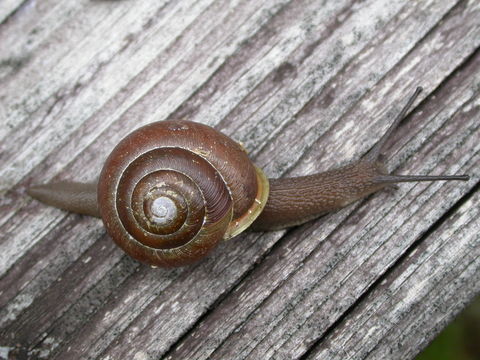Classification
The scientific name Inflectarius inflectus comes from the Latin root words inflect- (to bend in), -arius (pertaining to one), and inflectus (unmourned; not wept for) (Latin-Dictionary, 2008).
Formerly known as
Mesodon inflectus (Say, 1821).
Domain-Eukarya
Kingdom-Animalia
Phylum-Mollusca
Class-Gastropoda
Order-Stylommatophora
Family-Polygyridae
Genus-Inflectarius
Species-Inflectarius inflectus
Eukarya (Domain)- Eukaryotes have a nucleus with linear
chromosomes that are much more complex (Campbell
et al. 2008). They
are larger than prokaryotes, contain
membrane-bound organelles, and are able to
form multi-celled organisms.
Animalia (Kingdom)- Animals are
multicellular organisms composed of
eukaryotic cells. They cells are lack cell
walls and do not carry out photosynthesis.
Most animals, embryos pass through a
blastula stage.
Mollusca (Phylum)- A significant characteristic of molluscs is the coelom, a cavity that is filled with fluid developed within the mesoderm (Hickman et al. 2009). The coelom functions as a hydrostatic skeleton and a space for internal organs (Hickman et al. 2009). Molluscs have a soft body, which is generally protected by a shell. Another characteristic of molluscs is that they are bilaterally symmetrical (Hickman et al. 2009).
Gastropoda (Class)- Gastropods are unique because they have undergone torsion which is a twisting over the visceral mass. Torsion brings the anus and mantle cavity to a position that is above the head (Hickman et al. 2009). They also have a foot, a well developed head, and a radula.
Stylommatophora (Order)- Snails that have their eyes at the tips of their tentacles (Dictionary reference, 2012).
Polygyridae (Family)-Terrestrial air-breathing snails with no dart apparatus. The dart apparatus is a group of muscles that retract the eyes and the pharynx. Polygyridaes are also characterized by jaws that are ribbed (EOL, 2012).
Inflectarius (Genus)- Characterized by a medium sized shell and tan to brown colors. (Dourson, 2006). They also have two lip teeth, wit the upper tooth being larger (Franzen, 1944).
Inflectarius inflectus (Species)- About 5 mm in size. Comes from a wide variety of habitats including cave zones. Similar to Inflectarius rugeli. Differs in location of palatal tooth which is not as deeply recessed as in Inflectarius rugeli (Dourson, 2006).
The common name for Inflectarius inflectus is Shagreen. The origin of Shagreen is not known but the definition of shagreen comes from an untanned leather with a granular surface, prepared from the hide of a horse, shark, seal (Dictionary reference, 2012).